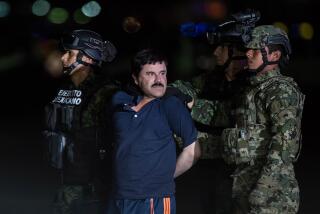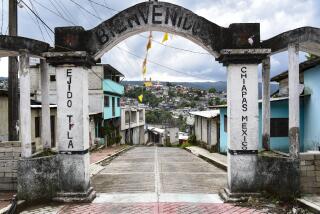Colombia Raises Government Profile in Former Rebel Zone
- Share via
SAN VICENTE DEL CAGUAN, Colombia — As this frontier town slept Saturday morning, Pvt. Daladio Torres and 300 comrades slipped into the main square at dawn, the first soldiers to enter the former rebel capital in three years.
Torres strode through the silence to a rebel flag flying at the square’s edge, tore it down and threw it in the nearest waste container.
“This is a disrespect to Colombia,” he said. “This flag belongs in the trash.”
With that, the Colombian army retook the largest city in the Switzerland-sized zone that the government ceded to the leftist Revolutionary Armed Forces of Colombia, or FARC, three years ago for peace talks.
As the takeover of the zone continued as smoothly as it had begun three days ago, there were neither casualties nor confrontations between the guerrillas and the army, military officials said. Most military analysts believe that the guerrillas have retreated into the nearby jungle.
Police and military officials said they had yet to enter all of the five towns in the zone, explaining that they were proceeding cautiously in a region the rebels have dominated for decades. Army patrols found a bus booby-trapped with explosives on one road, and they have discovered several minefields.
Also Saturday, the Colombian air force denied responsibility for the deaths of three people allegedly struck last week by a stray bomb. An air force official who declined to be named said that the three, including a 2-year-old boy and a 15-year-old girl, were at a cocaine processing lab when the bomb hit near a remote village about a five-hour drive north of Bogota, the capital.
In an emotional day for a country long divided over the decision to cede territory in the search for peace, Colombian President Andres Pastrana led a delegation of government officials, police and soldiers that arrived here to reestablish the government’s presence. Four U.S. Embassy officers, including the military attache, also accompanied him.
“We are here. We are with you,” said Pastrana, who was mobbed by crowds as he toured the town square. “We are going to continue working with you. We are going to continue working for peace in Colombia.”
Pastrana, who has staked his presidency on the success of the peace process, noted that negotiations had begun badly when rebel leader Manuel Marulanda failed to show up for opening ceremonies. The image of Pastrana sitting by an empty chair became a symbol of the fruitless talks.
Pastrana said he continues to believe that talks are the only way to bring an end to the country’s 38-year-old conflict. Nonetheless, he also said he is pushing for permission to use U.S.-donated helicopters and other equipment that are restricted to anti-drug efforts to directly combat the FARC.
The Colombian conflict pits the military and right-wing paramilitary groups against the FARC and a smaller leftist army, the National Liberation Army, or ELN. Washington has gradually become more involved as it seeks to stem the flow to the U.S. of Colombian cocaine, a source of revenue for both the paramilitary groups and the rebels.
Pastrana said that the rebels must “leave behind terrorism and leave behind narco-trafficking” before he will reenter negotiations.
“The solution continues to be a negotiated one,” said the president, who abruptly called off talks last week after the FARC hijacked a plane and kidnapped a senator. “We have to look for it.”
The FARC issued a statement in which it said it would negotiate with a “future government” more interested in the peace process.
The official presence here Saturday marked the newest phase of the government’s strategy, an all-out hearts-and-minds campaign to win over the estimated 100,000 people who live in the zone.
Pastrana promised that the government will invest in new roads and infrastructure throughout the long-ignored zone, a mostly unpopulated region of rolling hills that lead into the plains of eastern Colombia.
More than 30 soldiers from psychological operations and public relations arrived with the other troops. They handed out Colombian flags, bandannas and small notebooks that listed residents’ human rights under international conventions.
Soldiers were instructed to wave hello and chat with locals. They erected black-and-white banners in the main square and outside the town. “Trust your army!” one read. “We won’t fail you.”
This campaign promises to be difficult. Most residents were anxious about their fate at the hands of a military that in the past has frequently been linked to the paramilitary groups, which commit most of the massacres in Colombia.
“It’s a little worrisome for us,” said Oscar Rujillo, 35, a butcher who was slashing sides of beef as the soldiers passed. “You don’t know what’s going to happen.”
Then there is the complicated task of mending a region that has existed as the private fiefdom of leftist guerrillas who ruled through fear and showed little interest in improving the lives of locals.
Guerrillas frequently seized cars at gunpoint, giving them to militia members. During “judicial” hearings, they favored sympathizers, leaving residents who remained neutral without appeal. Many people disappeared without a trace. Others were found dead.
“There is going to be a settling of accounts,” said one man, who did not want to give his name. “That’s the danger.”
Yet another question hanging in the air this weekend is when authorities will begin attacking the zone’s coca fields. The area has been exempt from a controversial aerial fumigation program backed by the U.S., and the number of acres under cultivation has jumped from 20,000 to 50,000, according to Gen. Ernesto Gilibert, head of the national police.
He said that spraying would begin soon.
Despite the problems ahead, the mood here for most of Saturday was one of triumph.
Maj. Leonardo Acosta couldn’t help expressing his joy when another major called him via radio telephone.
“Listen,” he said. “Now San Vicente is part of the country again.”
More to Read
Sign up for Essential California
The most important California stories and recommendations in your inbox every morning.
You may occasionally receive promotional content from the Los Angeles Times.










